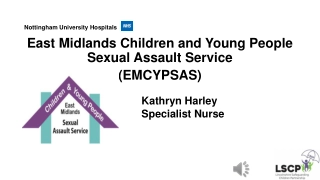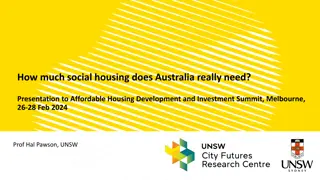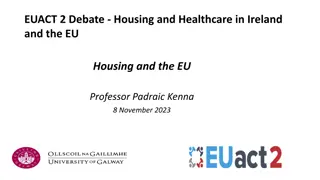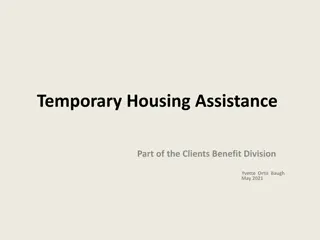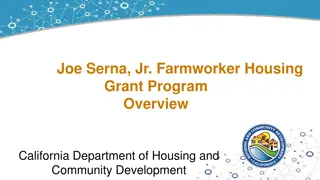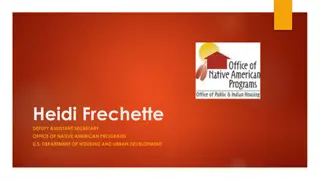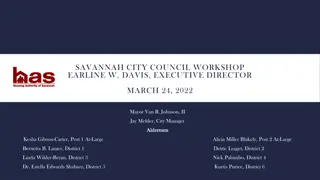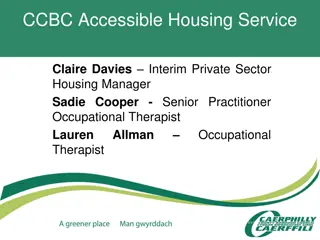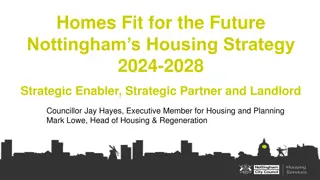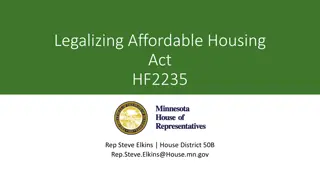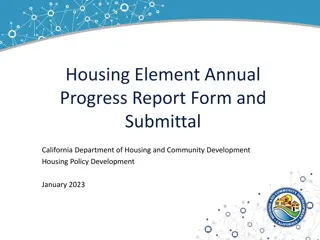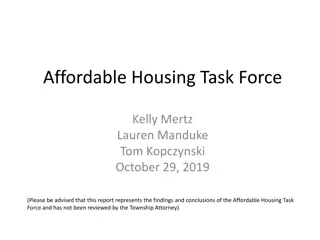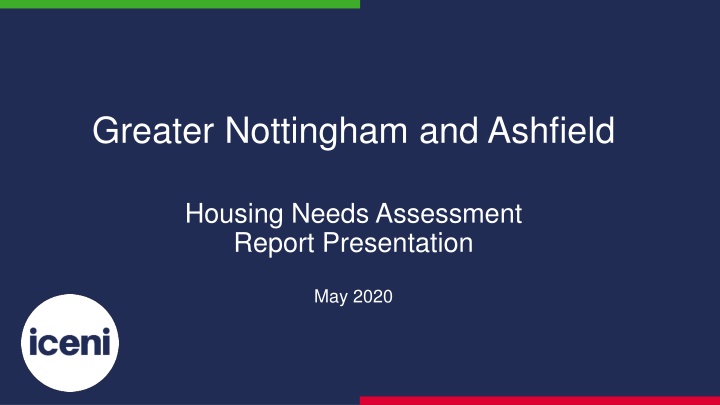
Greater Nottingham and Ashfield Housing Needs Assessment
The Greater Nottingham and Ashfield Housing Needs Assessment Report Presentation discusses the assessment conducted to support the preparation of Local Plans looking ahead to 2037 in Ashfield and 2038 in other authority areas. It highlights the methodology used to calculate housing needs, identifies submarkets based on house prices and housing profiles, and provides insights into affordable housing needs and housing mix. The report identifies 59 submarkets across the study area, emphasizing the importance of understanding variations in housing needs and market dynamics within different geographical boundaries.
Download Presentation

Please find below an Image/Link to download the presentation.
The content on the website is provided AS IS for your information and personal use only. It may not be sold, licensed, or shared on other websites without obtaining consent from the author. If you encounter any issues during the download, it is possible that the publisher has removed the file from their server.
You are allowed to download the files provided on this website for personal or commercial use, subject to the condition that they are used lawfully. All files are the property of their respective owners.
The content on the website is provided AS IS for your information and personal use only. It may not be sold, licensed, or shared on other websites without obtaining consent from the author.
E N D
Presentation Transcript
Greater Nottingham and Ashfield Housing Needs Assessment Report Presentation May 2020
Context to the Study The GNPP has commissioned Iceni Projects to prepare a Housing Needs Assessment. The National Planning Policy Framework ( NPPF , February 2019) sets out that Local Plans should positively seek opportunities to meet the development needs of their area, and be sufficiently flexible to adapt to rapid change and strategic policies should, as a minimum, provide for objectively assessed needs for housing and other uses. As part of this, the NPPF is also clear that the size, type and tenure of housing needed for different groups in the community should be assessed and reflected in planning policies. The Housing Needs Assessment has therefore been prepared for the Greater Nottingham and Ashfield area in order to support the preparation of Local Plans looking ahead to 2037 in Ashfield and to 2038 in all other authority areas; and to provide evidence to support housing market interventions and prospective future funding bids.
The Starting Point Overall Housing Need The assessment has used the local housing need standard method analysis throughout. 1: Household Growth Ashfield Broxtowe Gedling Erewash Nottm Rushcliffe derived to from inform the the 2014-based Growth (p.a.) 2020-2030 Household 434 314 401 345 1,086 451 2: Affordability Median Workplace-Based Affordability Ratio, 2019 The standard method of calculating local housing need is prescribed by Government. Local housing need is calculated over the 10 year period from 2020 to 2030 on an annual basis. 5.74 6.77 6.25 6.19 4.93 9.45 Adjustment Factor 11% 17% 14% 14% 6% 34% Minimum LHN 481 368 458 392 1,149 604 Across the study area, there is a need for 3,452 homes per annum with the local housing need for each local authority set out in the Table.
Submarkets Identification The report has sought to identify submarkets across the study area. across the study area differ greatly in terms of house prices and the profile of housing, it is helpful to identify submarkets to inform analysis and outputs on affordable housing needs and housing mix. As settlements Submarkets are helpful in establishing the appropriate level of affordable housing and the appropriate housing mix to be delivered in particular areas where the need is likely to differ greatly to the District-wide recommendations. The submarkets in the report have been built up using geographical boundaries at a ward level, using the latest 2019 ward boundaries. The analysis has principally been based on viability looking at the profile of housing sales across the study area as well as house price differentials/similarities. It is important to note that within submarkets, there will be some variances.
Submarkets - Outputs The analysis in the report has resulted in the identification of 59 submarkets across the study area. This is the same number as the 2007 SHMA; although this study includes the Ashfield District in its entirety. The submarkets in this study should be viewed at a point in time and will invariably be subject to change over time.
Affordable Housing - The Approach The affordable housing is based on the standard method (further detail in slide notes). approach to considering Future Housing Need Estimate of Newly-Forming Households in Need & Existing Households falling into Need over plan period Current Housing Need (Gross) Current Households in Housing Need based on Housing Register/secondary data sources The method draws on the traditional definition of affordable housing. Net Housing Need Arising Total Net Current Need The analysis is based on the entry- level rent (i.e. lower quartile) and how much of their income people tend to spend on renting in each local authority. Affordable Housing Supply Estimate of Supply of Affordable Housing from Relets of Existing Properties over plan period Affordable Housing Supply Supply of Affordable Housing from Vacant Stock & Development Pipeline Our assessment looks at affordable rented housing (social/affordable) and affordable home ownership. The latter has been introduced by the new NPPF. Total Net Current Need Over the Plan Period
Affordable Rented Housing (p.a.) Existing There is a relatively high level of affordable housing need per annum in comparison to overall housing need for all authority areas. This is particularly the case in Nottingham. Newly Total Current Households Relet Forming Gross Net Need Need Falling into Supply Households Need Need In comparison, the affordable rented figure alone is equal to 77% of the study area s local housing need. Ashfield 44 398 192 634 396 237 Broxtowe 44 364 78 486 178 309 Erewash 38 358 120 517 245 271 However, it is important to highlight that this figure is not a target and the link between overall need and affordable need is complex. Gedling 44 422 83 549 156 392 Nottingham 249 1,362 384 1,995 883 1,112 Rushcliffe 33 323 71 428 134 294 For instance, those not in accommodation (mainly newly forming households) are already captured in the demographic projections (i.e. included in housing numbers). It is therefore not a straightforward comparison exercise. Study Area 452 3,227 929 4,607 1,993 2,615 The affordable housing target will also have to be subject to viability testing.
Affordable Home Ownership The NPPF has introduced updated definition of affordable housing which includes households who might be able to rent without financial support but who aspire to own a home, and require support to do so. This expanded definition has been introduced by national Government to support increased access to home ownership, given evidence of declining home ownership and growth in private renting over the last 10-15 years. There is no specific guidance on how the needs of these households should be assessed. As a result, we have adopted a broadly consistent method to that set out in the PPG. We use the traditional calculation but this is based on those able to afford to rent but not buy. The supply is based on a range of: Max (number of homes sold at below lower quartile (i.e. entry- level) prices) and Min (number of homes sold at a price affordable to those able to afford to rent privately).
Affordable Home Ownership (p.a.) Total Gross Resale Supply Our analysis shows there is no real need for affordable home ownership products across the study area, except from in Rushcliffe Borough where house prices are notably higher. LCHO Supply Total Supply Net Need Need (50% of LQ) Ashfield 85 277 3 280 -195 Broxtowe 204 240 3 243 -39 However, authorities can choose to provide affordable home ownership products due to there being some households who would suit an affordable product. This is particularly true for particular affordable products such as Shared Ownership. Erewash 130 252 1 253 -123 Gedling 188 276 3 279 -92 Nottingham 118 582 9 591 -473 Rushcliffe 368 271 1 272 96 Study Area 1,093 1,898 21 1,919 -826 The authorities will have to weigh up the relative affordability of products (e.g. social rent vs low cost home ownership) and the viability of products. For example, providing more social housing will meet more acute needs but it is less likely to be viable and therefore fewer affordable homes are likely to be provided overall. Additional detail is provided in the slide notes.
Older Persons - Need for Accommodation Specialist Housing Need using SHOP@ Assumptions, 2020-38 Ashfield Ashfield Housing demand per 1,000 75+ 68 78 28 24 199 The assessment has also analysed the need for older persons accommodation. Additional demand to 2038 Current supply 2020 demand Current shortfall Shortfall by 2038 All of the individual local authorities show a notable increase in the older person population over the period from 2020 to 2038, with the increase in the population aged 65 and over varying from 29% in Broxtowe, up to 43% in Ashfield. Housing with support Housing with care Total (dwellings) Source: Derived from Demographic Projections and Housing LIN/EAC Broxtowe Rented Leasehold Rented Leasehold 197 0 10 0 207 781 903 327 279 2,290 584 903 317 279 2,083 453 523 190 162 1,328 1,037 1,426 507 441 3,410 Housing demand per 1,000 75+ 49 78 21 25 174 Additional demand to 2038 Current supply 2020 demand Current shortfall Shortfall by 2038 The Tables set out the need for specialist accommodation in Ashfield, Broxtowe and Erewash. Housing with support Housing with care Total (dwellings) Erewash Rented Leasehold Rented Leasehold 1,581 177 38 0 1,796 560 891 241 281 1,974 -1,021 714 203 281 178 276 439 119 139 973 -745 1,154 322 420 1,151 The greatest need is seen in Ashfield with a need for all forms of housing with support and housing with care. Housing demand per 1,000 75+ 55 76 24 24 179 Additional demand to 2038 Current supply 2020 demand Current shortfall Shortfall by 2038 Housing with support Housing with care Total (dwellings) Rented Leasehold Rented Leasehold 1,709 163 40 21 1,933 639 874 271 273 2,058 -1,070 711 231 252 125 334 457 142 143 1,076 -735 1,168 373 395 1,201
Older Persons - Need for Accommodation Gedling Housing demand per 1,000 75+ 51 78 22 24 175 Across all authorities, the majority of need falls within Housing with Support (i.e. retirement living/sheltered housing). Additional demand to 2038 Current supply 2020 demand Current shortfall Shortfall by 2038 Housing with support Housing with care Total (dwellings) Nottingham Rented Leasehold Rented Leasehold 1,330 105 64 0 1,499 588 901 252 284 2,025 -742 796 188 284 526 298 457 128 144 1,027 -444 1,253 316 428 1,553 It is important to highlight that the supply should be focussed on leasehold provision. In all authorities except Ashfield, there is no need identified for rented housing with support across the study area. Housing demand per 1,000 75+ 73 74 30 23 200 Additional demand to 2038 Current supply 2020 demand Current shortfall Shortfall by 2038 Separately, there are projected increases for dementia and mobility problems in all authority areas. Housing with support Housing with care Total (dwellings) Rushcliffe Rented Leasehold Rented Leasehold 3,746 290 423 218 4,677 1,280 1,304 531 399 3,514 -2,466 1,014 108 181 -1,163 662 675 275 207 1,818 -1,804 1,689 383 388 655 The growth shown in those with disabilities provides clear evidence justifying delivering accessible and adaptable homes as defined in Part Regulations Housing demand per 1,000 75+ 38 76 17 24 156 Additional demand to 2038 Current supply 2020 demand Current shortfall Shortfall by 2038 M4(2) of Building Housing with support Housing with care Total (dwellings) Rented Leasehold Rented Leasehold 905 394 93 80 1,472 470 936 207 299 1,911 -435 542 114 219 439 281 559 124 179 1,143 -155 1,101 238 397 1,582
Older Persons - Residential Care Bedspaces Housing demand per 1,000 75+ 129 112 116 113 130 101 118 The analysis shows a current shortfall and notable projected future need. Overall, it is estimated that there is a need for around 7,200 additional care and nursing home bedspaces to 2038 across the study area. Current shortfall/ surplus Additional demand to 2038 Shortfall/ surplus by 2038 Current supply 2020 demand Ashfield Broxtowe Erewash Gedling Nottingham Rushcliffe Study Area 1,089 1,043 861 1,004 768 1,674 6,439 1,482 1,277 1,332 1,310 1,237 2,274 8,910 393 234 471 306 469 600 2,471 855 630 695 659 736 1,177 4,752 1,247 864 1,165 965 1,205 1,777 7,224 The need is highest in Rushcliffe at 1,777 bedspaces and lowest in Broxtowe at 864 bedspaces. These figures should be considered as a maximum level, as there is potential for some of this need to be met through provision of extra care housing. This will relate to needs arising for residential rather than nursing care.
Younger Adults Change in Disabilities Projected Changes to Greater Nottingham and Ashfield Adult Population with a Range of Disabilities by LPA Area Disability Impaired Mobility Common Mental Disorder Autistic Spectrum Disorders Learning Disabilities Impaired Mobility Common Mental Disorder Autistic Spectrum Disorders Learning Disabilities Impaired Mobility Common Mental Disorder Autistic Spectrum Disorders Learning Disabilities Impaired Mobility Common Mental Disorder Autistic Spectrum Disorders Learning Disabilities Impaired Mobility Common Mental Disorder Autistic Spectrum Disorders Learning Disabilities Impaired Mobility Common Mental Disorder Autistic Spectrum Disorders Learning Disabilities 2020 4,348 2038 4,327 Change -21 % Change -0.5% The analysis shows first and foremost that there is a substantial volume of younger adults (aged 65 and under) across the study area with a range of disabilities. 14,529 15,029 500 3.4% Ashfield 755 779 24 3.2% 1,972 2,056 84 4.3% 3,799 3,643 -156 -4.1% The number of younger adults who are mobility impaired is expected to fall in Ashfield, Broxtowe, Gedling and Erewash; whilst the number is projected to increase by around 150 people in Nottingham and Rushcliffe. 12,839 13,122 283 2.2% Broxtowe 684 705 21 3.1% 1,743 1,806 63 3.6% 3,975 3,861 -114 -2.9% 13,090 13,249 159 1.2% National Planning Practice Guidance for Housing for Older and Disabled People refers only to specialist housing for older people; however, clearly local authorities should support specialist housing schemes for younger adults which come forward across the plan area. Erewash 681 687 6 0.8% 1,774 1,811 37 2.1% 4,073 4,091 19 0.5% 13,289 13,951 662 5.0% Gedling 685 722 36 5.3% Particularly supported housing schemes aimed at supporting those with autistic spectrum disorders and learning disabilities given these disabilities are expected to see an increase in all authority areas. 1,797 1,908 111 6.2% 9,205 9,340 135 1.5% 42,146 43,604 1,458 3.5% Nottingham 2,299 2,424 125 5.4% 5,871 6,161 290 4.9% 4,040 4,222 182 4.5% 13,048 14,420 1,373 10.5% Rushcliffe 688 758 70 10.2% 1,779 1,980 201 11.3% Source: POPPI/PANSI and Demographic Projections
Housing Mix - The Approach The report has also set out to consider the appropriate housing mix to be sought on development schemes across the study area. Demographic Changes The analysis considers the mix of housing for three broad categories: Market Housing Affordable Home Ownership Affordable Rented Housing Economic Growth Accessibility Improvements Future Housing Mix By following a method that takes account of future demographic change, the way in which households occupy homes in different tenures (and by age) and consideration of the current stock profile, a series of outputs have been derived to consider the likely size requirement of housing within each of the three broad tenures. Current Housing Mix Housing Affordability
The Recommended Housing mix Authority Housing Type Market Affordable Home Ownership Affordable Rented Market Affordable Home Ownership Affordable Rented Market Affordable Home Ownership Affordable Rented Market Affordable Home Ownership Affordable Rented Market Affordable Home Ownership Affordable Rented Market Affordable Home Ownership Affordable Rented 1 Bed 4% 23% 35% 12% 20% 21% 7% 20% 26% 3% 20% 25% 11% 15% 25% 11% 19% 40% 2 Beds 27% 38% 37% 31% 42% 40% 32% 37% 44% 30% 38% 44% 29% 46% 41% 28% 40% 29% 3 Beds 46% 24% 25% 40% 32% 33% 42% 32% 27% 48% 31% 27% 42% 34% 31% 40% 39% 29% 4+ Beds 24% 15% 3% 18% 6% 6% 19% 12% 4% 19% 11% 3% 18% 5% 2% 21% 3% 2% We have used our modelled outputs and have taken into account recent supply since the 2011 Census to arrive at a recommended housing mix. Ashfield Broxtowe It needs to be noted that to some degree the outputs seek to address the current stock profile. However, it may the case that moving too far away from the current mix could be unrealistic in some areas. Erewash Gedling It will be appropriate for authorities to be flexible with policy to respond to differing submarket characteristics. Nottingham Rushcliffe
Private Renters Growth The analysis shows that the private rented sector has grown as a sector in each of the authority areas across the last three census points. As a proportion of all households, the private rented sector was the second largest tenure in Broxtowe (14.1%), Gedling (13.1%) and Rushcliffe (13.3%) at the point of the 2011 Census. Nottingham had the highest proportion of private renters at households. 23.1% of all It should be noted however that Census data is outdated, with recent research suggesting the private rented sector has grown substantially (e.g. up to 31% of all households in Nottingham as at 2018)
Private Renters - Build to Rent Policy In the context of the private rented sector s growth, successive Governments have looked to the private rented sector to play a greater role in providing more new build housing and have sought to encourage Build to Rent development. The benefits of Build to Rent have been recognised as including: Supporting the Local Community help meet demand for private rented sector housing whilst increasing tenants choice. This includes offering longer tenancies and maximising occupancy levels as Build to Rent investment is an income focussed model. Supporting Local Growth increases housing supply, particularly on large, multi phased sites as it can be delivered alongside for sale and affordable housing. Improves placemaking as the market absorption rate the sector is higher than build for sale. Financial Benefits authorities can become directly involved in the provision of Build to Rent, given the potential to generate income or capital receipts. Currently there is no policy in place in the authority areas. Government has been clear that where a need is identified, local planning authorities should include a specific plan policy relating to the promotion and accommodation of Build to Rent. Iceni consider there is a need and a role for Build to Rent in responding to and supporting those various groups within the sector in all authority areas.
Next Steps & Final Report The final report will incorporate submarket-level outputs on affordable housing need and will provide commentary on the criteria to be applied at a submarket level for housing mix. Once submarket analysis is factored in, we will be circulating as a final draft for comment recommendations and conclusions. which will include Iceni will then be able to address any final comments promptly and reissue for sign-off.

